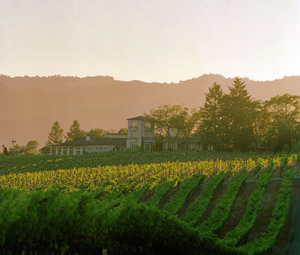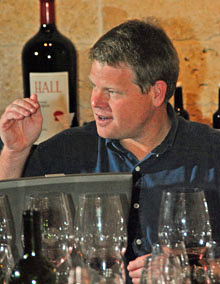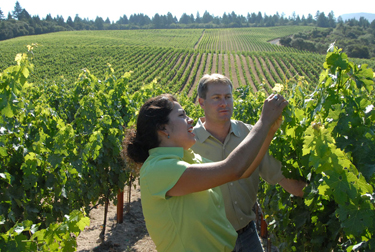

High above Napa Valley's scenic Silverado Trail, HALL Wines has its terroir-driven Rutherford estate and one of its two wineries.
A Bow to Terroir
HALL Wines Decks Its Portfolio
with Single Vineyard Wines
Despite the ambassadorship and the Gehry-designed winery, HALL seems intent on single-vineyard wines, as an interview with its President and Vineyard Manager reveals.
by
Alan Goldfarb
June 28, 2007
ALAN GOLDFARB (AG): I’ve heard that you’re interested in terroir and in making distinctive wines from your various vineyards. A lot of people say that, but it’s usually difficult to discern those differences. How do you at HALL plan on achieving that?

HALL Wines President Mike Reynolds.MIKE REYNOLDS (MR): It’s true this isn’t a story that you’ve not heard a thousand times before, but all those things that go into terroir – climate, soil, aspect, location -- come into play.
PATTY SALDIVAR (PS): If you took one winemaker across how many appellations and one varietal – Cabernet – I think it will start to become a little clearer. The winemaking has just as much impact as does terrior.
MR: However, within a certain winemaking style, it will start to manifest itself and as we add more vineyards to our stable, you will be able to see the differences between the locations. A lot of wineries and winemakers are into full manipulation – extract everything, 125 percent oak, lees contact, and squeeze the be-jeebers out of the wine. But there are winemakers that not only walk the walk, but they talk the talk.
We make wines that are not over-oaked … and we are invested in those sites, and the wines that are made from those places.
PS: The philosophy in the vineyard is to not require a lot of manipulation. … The requirement is just to shepherd the grapes to maturity.
MR: We’re trying to make the right selections – rootstocks, clones, spacing, crop management, and direction at time of planting -- so that we’re not putting in a lot input during the course of the season. If we made the right selections out of the gate, than the vines won’t require the inputs (later). If we make right choices initially, than we’re not making changes to fix inefficiencies (such as) water, etc.
AG: Are you going to purchase more vineyard land?
MR: We’re always interested. Until we find potential properties that come up to purchase, we’re purchasing grapes. (Note: Such as the undisclosed sources from Diamond Mountain, Spring Mountain, Mount Veeder, and Atlas Peak.)
We want to have a portfolio of Cabernets specifically that come from what we consider to be the premier appellations of the Napa Valley. Each is unique in its own way.
(But) while we have this portfolio of vineyard-specific wines, the core of what we produce is the many blends of Napa Valley grapes.
AG: So, why is it important to you to have single-vineyard wines?
MR: There’s a uniqueness about them that you lose with blends. I could make this argument both ways: My background is in sparkling wines (at Schramsberg) and I’m a believer in the cuvee (blend). At the same time, there’s a uniqueness from each vineyard that you begin to lose. When you begin to blend it, you lose what’s unique and individualistic. There’s a group of people (consumers) out there who believe in the single-vineyard wines.
AG:: Let’s go over each of those Napa Valley vineyards (see sidebar) and talk about the physical properties of each, and how it manifests in the bottle. First is the Hall Estate in St. Helena.
PS: There’s cover crop and it’s mowed rather than disced for soil health, organic matter and (mowing) helps the nutrients in the soil. The organic matter breaks down naturally and we’re able to control some of the moisture in the soil.
MR: This used to be the path of Silver Creek, so it’s an ancient river bed.
AG: How does the estate fruit manifest in the glass?
MR: There’s real strength of fruit character, blackberry pie. When it’s ripe, it oozes of rich, dark fruit. On the palate, it has a powerful, dense structure.
AG: Next is Sacrashe (pronounced SAC ra chay) in Rutherford.
PS: Here, you have a smaller difference at the upper elevations between daytime highs and nighttime lows, so you’re not exposing the fruit to heat that will damage it. It’s (the growing season) more gentle. (The grapes are) slow cooked versus micro-waved.
MR: It’s totally different (from the estate vineyard wines) because of the rocky hillside, shallow soils, (which give) a tannic backbone (to the wine), with lots of deep berry fruit. But there’s more complexity -- earthy, dusty components, with chocolate and coffee. The wines are big and soft, with lush tannin, not harsh tannin. But you can definitely tell it’s a mountain wine.
AG: Next up is the Napa River Ranch, which is just north of the city of Napa.
PS: This vineyard is dry-farmed. The water is generous and high (because of the confluence of the various creeks and river). Planting is dense, more tightly spaced (1,800-2, 400 vines per acre), because a smaller plant carries smaller fruit loads, and brings a lot more concentration.
MR: The Merlot is concentrated, dense, and jammy. We’re trying for a ripe Merlot. Because it’s dry-farmed, we’re not irrigating, so what we end up getting is a low-yield, concentrated Merlot with great power. A lot of people are surprised it’s not a Cabernet.
AG: What about Hardester Ranch (Pope Valley)?
PS: This is a vineyard that requires a little more finessing, a little more input on our part to get what we want. Because it is a warmer environment, and harsher soil environment, we use misters and
Vineyard Manager Patty Saldivar shows new grape development to HALL winemaker Richard Batchelor.overhead sprinklers to bring down the temperatures in the hottest part of the season. This is the one vineyard where strict attention to water needs is important
MR: (The Cabernet, Merlot and Petit Verdot from here are used in HALL’s Napa Valley blend.) Twenty-five percent of our Sauvignon Blanc comes from this vineyard. It’s flowery, with good acidity. If we farmed it well, it’s not terribly phenolic (compounds which give the wine color). We have a champagne mentality (with this wine), minimizing the phenolic extraction. The Merlot is amazingly dense. The Petit Verdot has lots of color, acidity, and lends a floral note. The Cab is big, ripe, and fruit-full.

HALL Wines President Mike Reynolds.
PATTY SALDIVAR (PS): If you took one winemaker across how many appellations and one varietal – Cabernet – I think it will start to become a little clearer. The winemaking has just as much impact as does terrior.
MR: However, within a certain winemaking style, it will start to manifest itself and as we add more vineyards to our stable, you will be able to see the differences between the locations. A lot of wineries and winemakers are into full manipulation – extract everything, 125 percent oak, lees contact, and squeeze the be-jeebers out of the wine. But there are winemakers that not only walk the walk, but they talk the talk.
We make wines that are not over-oaked … and we are invested in those sites, and the wines that are made from those places.
PS: The philosophy in the vineyard is to not require a lot of manipulation. … The requirement is just to shepherd the grapes to maturity.
MR: We’re trying to make the right selections – rootstocks, clones, spacing, crop management, and direction at time of planting -- so that we’re not putting in a lot input during the course of the season. If we made the right selections out of the gate, than the vines won’t require the inputs (later). If we make right choices initially, than we’re not making changes to fix inefficiencies (such as) water, etc.
AG: Are you going to purchase more vineyard land?
MR: We’re always interested. Until we find potential properties that come up to purchase, we’re purchasing grapes. (Note: Such as the undisclosed sources from Diamond Mountain, Spring Mountain, Mount Veeder, and Atlas Peak.)
We want to have a portfolio of Cabernets specifically that come from what we consider to be the premier appellations of the Napa Valley. Each is unique in its own way.
(But) while we have this portfolio of vineyard-specific wines, the core of what we produce is the many blends of Napa Valley grapes.
AG: So, why is it important to you to have single-vineyard wines?
MR: There’s a uniqueness about them that you lose with blends. I could make this argument both ways: My background is in sparkling wines (at Schramsberg) and I’m a believer in the cuvee (blend). At the same time, there’s a uniqueness from each vineyard that you begin to lose. When you begin to blend it, you lose what’s unique and individualistic. There’s a group of people (consumers) out there who believe in the single-vineyard wines.
AG:: Let’s go over each of those Napa Valley vineyards (see sidebar) and talk about the physical properties of each, and how it manifests in the bottle. First is the Hall Estate in St. Helena.
PS: There’s cover crop and it’s mowed rather than disced for soil health, organic matter and (mowing) helps the nutrients in the soil. The organic matter breaks down naturally and we’re able to control some of the moisture in the soil.
MR: This used to be the path of Silver Creek, so it’s an ancient river bed.
AG: How does the estate fruit manifest in the glass?
MR: There’s real strength of fruit character, blackberry pie. When it’s ripe, it oozes of rich, dark fruit. On the palate, it has a powerful, dense structure.
AG: Next is Sacrashe (pronounced SAC ra chay) in Rutherford.
PS: Here, you have a smaller difference at the upper elevations between daytime highs and nighttime lows, so you’re not exposing the fruit to heat that will damage it. It’s (the growing season) more gentle. (The grapes are) slow cooked versus micro-waved.
MR: It’s totally different (from the estate vineyard wines) because of the rocky hillside, shallow soils, (which give) a tannic backbone (to the wine), with lots of deep berry fruit. But there’s more complexity -- earthy, dusty components, with chocolate and coffee. The wines are big and soft, with lush tannin, not harsh tannin. But you can definitely tell it’s a mountain wine.
AG: Next up is the Napa River Ranch, which is just north of the city of Napa.
PS: This vineyard is dry-farmed. The water is generous and high (because of the confluence of the various creeks and river). Planting is dense, more tightly spaced (1,800-2, 400 vines per acre), because a smaller plant carries smaller fruit loads, and brings a lot more concentration.
MR: The Merlot is concentrated, dense, and jammy. We’re trying for a ripe Merlot. Because it’s dry-farmed, we’re not irrigating, so what we end up getting is a low-yield, concentrated Merlot with great power. A lot of people are surprised it’s not a Cabernet.
AG: What about Hardester Ranch (Pope Valley)?
PS: This is a vineyard that requires a little more finessing, a little more input on our part to get what we want. Because it is a warmer environment, and harsher soil environment, we use misters and

Vineyard Manager Patty Saldivar shows new grape development to HALL winemaker Richard Batchelor.
MR: (The Cabernet, Merlot and Petit Verdot from here are used in HALL’s Napa Valley blend.) Twenty-five percent of our Sauvignon Blanc comes from this vineyard. It’s flowery, with good acidity. If we farmed it well, it’s not terribly phenolic (compounds which give the wine color). We have a champagne mentality (with this wine), minimizing the phenolic extraction. The Merlot is amazingly dense. The Petit Verdot has lots of color, acidity, and lends a floral note. The Cab is big, ripe, and fruit-full.
 READER FEEDBACK: To post your comments on this story,
click here
READER FEEDBACK: To post your comments on this story,
click here
Print this article | Email this article | More about Napa Valley | More from Alan Goldfarb













